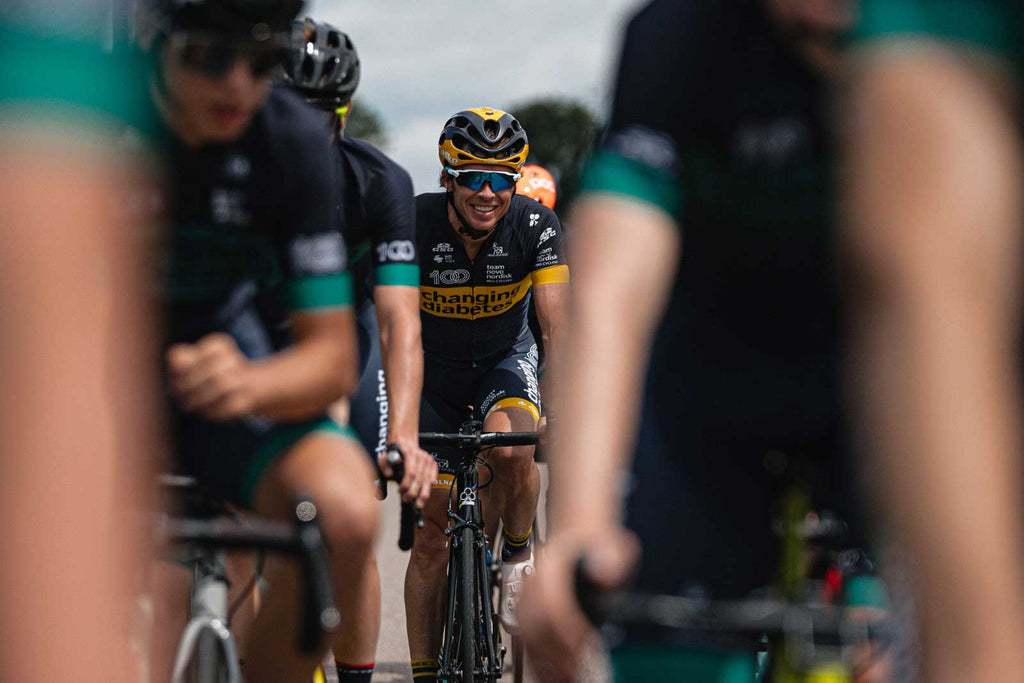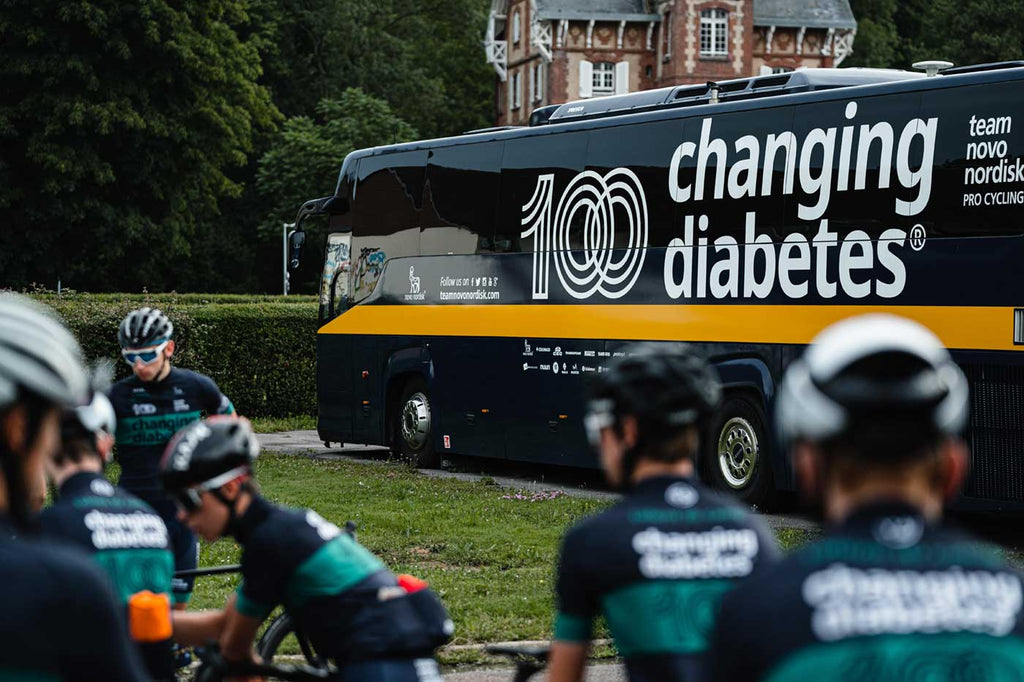What is Supersapiens? The story behind the next frontier in performance
The Supersapiens energy management system may be the breakthrough product of 2021. We examine why the world’s greatest riders, runners, and F1 stars are tapping into a device that revolutionised the lives of athletes living with diabetes...
The SRM power meter, Scott’s clip-on aerobars, Look’s clipless pedals – all ground-breaking inventions in the sport we love. But what’s next? What innovative product will be adopted and honed by the elite few before spreading like wildfire to the amateur masses?
Well, according to Phil Southerland, and an increasing number of users around the world, there’s only one answer. “Supersapiens, powered by Abbott Libre Sense, is the new frontier in performance,” the company’s founder tells us from across the Atlantic before hot-footing it over to the Tour de France to catch up with teams using the product, including Ineos-Grenadiers and Jumbo-Visma. “We foresee that CGM – or continuous glucose monitoring – will become as important as other metrics that cyclists use to transform their cycling, like heart rate and wattage.”
On the face of it, hyperbole. But dig a little deeper – as deep as the biosensor’s thin filament that measures your interstitial glucose levels, in fact – and you realise that there’s more to Supersapiens than a marketing soundbite. Southerland’s a pragmatist who’s lived with type-1 diabetes since just seven months old. He’s now 39. His parents were told he’d be dead or blind by 25. Thankfully, they were stubborn and their determination secured Southerland junior access to the latest blood-glucose monitoring tools and the finest medical teams.
Southerland’s strength and confidence grew. At 12, he discovered the bike. By 2007, he’d spearheaded an all-diabetes team who not only won that year’s RAAM (Race Across America) but set a new world record in the process. Soon after, Phil and the team partnered with healthcare company Novo Nordisk to create Team Novo Nordisk, the world’s first all-diabetes professional cycling team, who exist to this day — competing in the UCI ProSeries. In short, Southerland’s game-changing rhetoric is born from experience, not a sales script.

Phil Southerland on training camp with Team Novo Nordisk. Photo Credit: Thomas Maheux
Related – Is a plant-based diet suitable for road cyclists?
“I’ve been using the technology in Supersapiens in one form or another for 15 years now and I rarely carry a fingerstick with me anymore,” he says. “In fact, the last time I pricked my finger to check my glucose levels was three months ago. I’ve corroborated my CGM readings against something called HbA1C, which is a three-month report card for people with diabetes, and they’re the same. It works, not only for diabetics like myself, but for every rider.”
(NB: The Libre Sense is not indicated for diabetes and is intended for sports/athletes use).
How It Works
Daniel Healey is an exercise physiologist and sports nutritionist who’s the resident expert for Rouleur Performance. He has an in-depth knowledge of CGM and its use for recreational cyclists, and over the next few weeks he will offer a more physiological explanation of how the Supersapiens tool works. For now, here’s a truncated explanation. And it’s pretty simple:
Download the Supersapiens app and then insert the Abbott’s Libre Sense Glucose Sport Biosensor into your arm. Okay, that might not sound emotionally simple as the thought of inserting a tiny filament might not appeal. But believe us – we had reservations, tried it and couldn’t believe how imperceptible it was (even during restless nights in that July hot spell). The sensor then streams minute-by-minute glucose data to the app, all in the name of managing your fuel levels for optimum performance.

And it’s this lifting of the nutritional lid that’s attracted significant investment with early-stage funding closing on $13.5 million. Until now, myriad training tools exist to measure myriad performance metrics. But fuelling has very much been left to trial, error and feel. Which as endurance athletes is an anomaly, especially as hitting the wall awaits if you get it wrong. Supersapiens, it seems, could fill this fuelling void.
The system is up and running, and being put to use by many athletes across the globe — Supersapiens ecosystem is available in Austria, France, Germany, Ireland, Italy, Luxembourg, Switzerland, and the United Kingdom, so the technology is not yet available in the US.
“But it’s no wonder drug,” says Southerland. “It’s just an opportunity for you to learn, to study, to intervene, to be the best rider you can be. It takes time. I’ve been studying myself for 30 years and still have surprises on rides. That’s why you really need at least a couple of months using Supersapiens to see how you respond to different foods and different sessions before making suitable interventions. As cyclists, of course, we’re used to testing, whether it’s different intervals to see how they affect our FTP (functional threshold power) or different gear ratios on different climbs. It’s the same with CGM.”
Usability is Key
The app’s usable as it is but, going forward, Southerland says the team are set to simplify things further. “We’ll break it down into three key areas. One is ‘Prime’. This is around four to five hours leading up to when you head out to ride. If it’s a recovery ride or something easy, it’s not a biggy. But for those rides where you really want to focus and hone in on specific adaptations, priming is key. How you fuel around 12 to 24 hours before a big session or race is important. It’s even more so in those last four to five hours. And there are other considerations between that time and the start.

Southerland created Team Novo Nordisk, the world’s first all-diabetic professional cycling team. Photo credit: Thomas Maheux
“The next area is ‘Perform’. Where do you need your glucose to be for peak performance? Once you find those numbers that are good for you – whether it’s eating porridge for breakfast with or without jam, for example – look back at the priming phase and reverse engineer your own strategy to ensure you stay in that performance zone as much as possible.
“The final one is ‘Recover'. We have plenty of data showing that if your glucose levels go below around 72 mg/dL after exercise, it impedes the muscle’s ability to absorb glycogen from a recovery standpoint. Taking advantage of data for recovery fueling is a game changer.”
Frequency That Fits You
How often you’d use a CGM tool like Supersapiens is, according to Southerland, down to what category of rider you fall into. The ‘curious’ athlete who’s searching to lose 10-20lbs might try it for a month every quarter. Observe, make nutritional adjustments, and observe again. And then there’s the rider who might have a major ride like the Mallorca 312 or the Haute Route in three month’s time and are looking to understand their body in the build-up. Finally, you have the ‘serious’ rider who could well wear it all-year-round.
Or runner. Kenya’s Eliud Kipchoge, regarded as the greatest endurance athlete of all time by many and the only human to dip under two hours for the marathon, has been using it throughout 2021. “It’s been encouraging how Eliud and his team have worked with Supersapiens,” says Southerland. “His coaching team looked at the data for two months before sharing it with Eliud. It was only then that they started making nutritional interventions.”

Eliud Kipchoge has used Supersapiens technology. Photo: Naomi Baker/Getty Images
Find out if the science adds up by tuning into the men’s marathon on Saturday 7th August. Or the Hungarian Grand Prix on Sunday 1st August, as F1 legend Lewis Hamilton’s a user. The frontline stars are matched behind the scenes by a team of experts familiar to road cyclists.
High-Profile Investors
“We have a lot of investors coming on board,” says Southerland. “There’s Chip [Hawkins, Founder of Wahoo Fitness], who’s the reason we have a business today. He’s an investor and advises me on a weekly basis. He’s helped with the Supersapiens Energy Band, a wrist wearable device that will display real-time glucose data, which will be launched soon. Supersapiens will be on Wahoo soon, too, adding to Garmin, which we’re already on. We’re regularly testing our performance together as we’re training for Ironman Kona in October.”
Chris Froome’s an investor, too, and Southerland credits CGM for helping Froome make race weight for this year’s Tour. Quick-Step, numerous French teams, Qhubeka-Assos, Anna van der Breggen and, as mentioned, Ineos-Grenadiers,Jumbo-Visma and Canyon-Sram, have all been using the product. The latter enjoy arguably a bespoke touch as their head of nutrition and sport scientist, Asker Jeukendrup, is one of the brains behind Supersapiens.
That’s quite a coup as Jeukendrup is regarded as the God of Glucose, popularising the glucose-fructose range of gels for Powerbar many years ago that, in theory, increased the amount of sugar a rider could metabolise each hour from 60g to 90g. Before the discovery, gels generally contained glucose only, but intestinal transportation reached saturation point at 60g. Any more and stomach issues lay ahead. Jeukendrup’s research showed that adding fructose to the mix, which used a different intestinal transportation, upped carbohydrate capabilities and so cranked up rider performance. “Asker’s also helping run our Supersapiens University,” says Southerland. “It’s a platform that we’re using to educate coaches on how to use their clients.”

Chris Froome is amongst the Supersapiens investors. Photo: Noa Arnon
And that, concedes Southerland and from our own experience of using the product, is key as the streams of interesting data remains just that if you’re blind to what you should do with that data. “We’re constantly working on that aspect and it’ll become an even more user-friendly product as time goes by. But, in all honesty, we feel from rider feedback that it’s still a game-changing product as it is.”
Educating the UCI
Too game-changing for the UCI by the looks of it, as cycling’s global governing body banned the use of CGM tools like Supersapiens from races earlier this year, vaguely because of fears of making cycling like F1, as well as leading to performance inequality in young riders. “It’s our job to explain the product, why it’s so important and the different physiological mechanisms at play,” says Southerland.
“The literature in exercise-physiology textbooks says that a non-diabetic has complete control over their glucose, so you can understand [why they made the decision],” he continues. “But when people are on the bike, everyone’s a diabetic! All have spikes, all have [sugar] crashes and, more importantly, many have hypoglycaemia while riding. This affects motor skills, affects your brain, affects your ability to push power…
“You can measure power in races, heart rate and even core temperature. This is the only metric that’s banned and doesn’t fall in line with the precedent that’s been set. Then again, we’ve got to work with them, to educate them. To be honest, I must also thank the UCI as they’ve given us dispensation to use this type of product at Team Novo Nordisk for years.”
Somewhat surprisingly, professional teams can still use Supersapiens in training, while recreational riders can use it everywhere. And they are doing so in ever-increasing numbers. “If you can’t measure it, you can’t improve it” is a mantra preached by many road cyclists.
The journey is far from over for Supersapiens, but if the practice lives up to the theory, we might expect glucose-monitoring patches to become as ubiquitous as heart rate monitors. And we could see some historic leaps forward in performance.
Produced in collaboration with Supersapiens






























